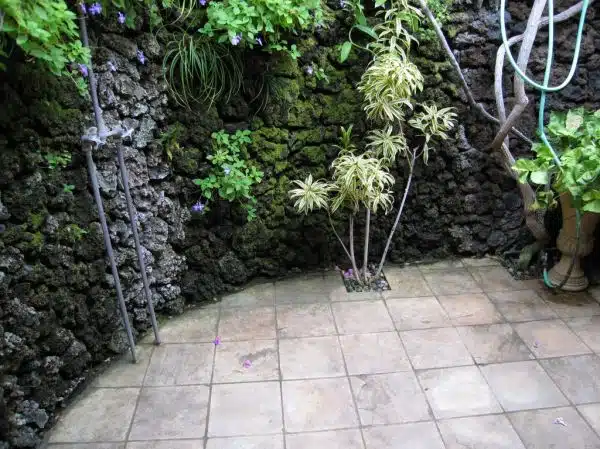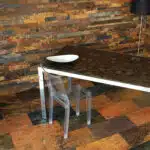Outdoor tiles are a popular choice for homeowners looking to enhance the exterior of their homes. They not only add aesthetic value but also increase the functionality of outdoor spaces. One can choose from a variety of materials, including ceramic, porcelain, natural stone, and concrete pavers. However, installing outdoor tiles can be a daunting task if you don’t have experience or know-how. In this article, we will guide you through the steps required to install outdoor tiles professionally.
To ensure your outdoor tile installation is successful, it’s essential to prepare adequately before starting the project. This involves selecting the right type of tile for your needs and climate conditions, measuring your space accurately, and preparing a solid substrate for the tile to adhere to. Additionally, having the proper tools and equipment is vital in achieving a professional finish. In this guide, we will cover all these aspects in detail and provide tips on how to complete your outdoor tile installation with ease and precision.
Advantages Of Outdoor Tile
Outdoor tile is a popular choice for homeowners and designers alike due to its numerous advantages. The first advantage of outdoor tile is its design options. With an extensive range of styles, colors, and textures available, outdoor tiles can be customized to suit any aesthetic preference. Whether you’re looking for a classic or modern look, there’s an outdoor tile option that will meet your needs.
Another advantage of outdoor tile is its durability. Outdoor tiles are built to withstand harsh weather conditions, making them ideal for areas that experience extreme temperatures or heavy precipitation. They are also resistant to fading, chipping, and cracking, ensuring that they maintain their original appearance over time.
Lastly, outdoor tile is easy to maintain. Regular cleaning with mild soap and water is all that’s needed to keep the tiles looking their best. Additionally, if a tile does become damaged or stained, it can be easily replaced without having to remove the entire surface.
When considering installing outdoor tile, it’s important to choose the right type of tile based on factors such as slip-resistance and climate compatibility. By selecting the appropriate type of tile for your specific needs, you can ensure your investment will last for years to come.
Choosing The Right Type Of Tile
When it comes to choosing the right type of tile for outdoor use, there are a few key factors that need to be considered. One of the most important factors is tile durability. Outdoor tiles need to be able to withstand exposure to the elements, including rain, wind, sun, and even snow. Look for tiles that are specifically designed for outdoor use and have a high level of durability.
Another important factor when choosing outdoor tile is slip resistance. Outdoor areas can become slippery when wet, so it’s essential to choose a tile that provides good traction even when it’s wet. Look for tiles with a textured surface or ones that have been treated with an anti-slip coating. This will help prevent slips and falls and ensure that your outdoor space is safe for everyone who uses it.
Overall, selecting the right type of tile for your outdoor space requires careful consideration of both durability and slip resistance. By finding tiles that meet these criteria, you can ensure that your outdoor area looks great and functions well for years to come. In the next section, we will discuss how to determine the amount of tile needed for your project so you can get started on your installation with confidence.
Determining The Amount Of Tile Needed
Calculating the amount of tile needed for your outdoor project is crucial to ensuring that you stay within your budget and timeline. Before you start purchasing tiles, take accurate measurements of the area where the tiles will be installed. This will give you an idea of how much tile you need to purchase.
To calculate how much tile you need, multiply the length by the width of the space being tiled. Make sure to add approximately 10% extra for waste, cuts, and future repairs. This will give you a good estimate of how many square feet of tile you need to purchase. Once you know how many square feet are required, check with your local tile supplier to see what quantities they sell in.
Estimating your project timeline is also important when calculating the amount of tile needed. Consider factors such as preparation time, installation time, and curing time when planning your project timeline. This will help ensure that everything runs smoothly and on schedule.
Now that you have calculated the amount of tile needed for your outdoor project and estimated your project timeline, it’s time to move on to measuring your space accurately. A precise measurement is essential in determining how much material is required for your project while staying within budget constraints. Follow our next section closely for tips on taking accurate measurements before moving on to purchasing materials for installation.
Measuring Your Space
After determining the amount of tile needed, the next step is to measure your outdoor space. Measuring accuracy is crucial in ensuring that you purchase enough tile and avoid any waste. Common mistakes include measuring too little or too much, which can lead to additional costs and delays in the installation process.
To measure your outdoor space accurately, you will need a tape measure, pencil, and paper. Begin by measuring the length and width of your outdoor area in feet. Multiply these two measurements to get the total square footage of your space. It’s also essential to factor in any areas that won’t be tiled, such as walkways or garden beds.
Another common mistake is not accounting for cuts when purchasing tile. Remember that some tiles will need to be cut to fit around corners or edges, so it’s best to purchase extra tiles just in case. Once you have accurate measurements and have factored in cuts, you’re ready to move on to preparing the surface for installation.
Preparing the surface for installation is vital in ensuring that your outdoor tile lasts for years to come. Start by cleaning the area thoroughly, removing any debris or dirt from the surface. Next, inspect for any cracks or unevenness and make necessary repairs before proceeding with installation. When preparing a concrete surface, ensure that it’s cured correctly before installing any tile on it. Proper preparation ensures a smooth and successful installation process.
Preparing The Surface For Installation
Surface preparation is crucial for a successful outdoor tile installation. The surface must be clean, dry, and free of any debris or loose material. Start by removing any existing tiles or flooring using a scraper or chisel. Next, use a pressure washer to remove dirt, grime, and any remaining adhesive residue.
Once the surface is clean, the next step is to level it. Any unevenness in the surface can cause problems with the tile installation. Use leveling techniques such as self-leveling compound or mortar to smooth out any bumps or dips in the surface. Follow manufacturer instructions for mixing and applying these products carefully, as improper application can lead to cracking or other issues.
After completing surface preparation and leveling, allow ample time for everything to dry completely before moving on to the next steps of the installation process. Proper preparation will ensure that your outdoor tile installation lasts for years to come without any issues caused by an uneven or poorly prepared surface.
When it comes to installing outdoor tiles successfully, having the right tools and materials is essential. In order to complete an outdoor tile installation project efficiently and effectively, you’ll need a variety of tools including a trowel, notched trowel, spacers, measuring tape, leveler, and rubber mallet. Additionally, you’ll need materials such as cement board screws or nails, waterproof membrane roll-on adhesive & fabric sheets which are necessary for waterproofing your substrate prior laying down your tiles on top of it. By making sure you have all the necessary tools and materials ahead of time will make this task much easier!
Tools And Materials Required For Installation
Having prepared the surface for installation, it’s now time to gather the necessary tools and materials required for the job. Tool safety is of utmost importance when working with tile. Always wear protective gear, such as gloves and goggles, to avoid injury from shards or dust created during cutting.
In addition to tool safety, proper cutting techniques and pattern design can make all the difference in creating a seamless outdoor tile installation. When cutting tile to fit your space, ensure that measurements are precise and cuts are made with a wet saw or tile cutter. This will reduce the risk of chipping or cracking the tile during installation.
To achieve a unique design, experiment with different patterns before committing to one specific arrangement. Consider factors such as color variation and directionality when laying out tiles in a particular pattern. With these tips in mind, you’re well on your way to installing beautiful outdoor tiles that will withstand the test of time.
Cutting Tile To Fit Your Space
As you begin to install outdoor tile, you may find that some areas require tiles to be cut in order to fit properly. Cutting tile can be a tricky process, but with the right cutting techniques and a little patience, you can customize the shape of your tiles to perfectly fit your space.
One important cutting technique is using a wet saw. A wet saw uses water to cool the blade and prevent heat from damaging the tile. It also helps keep dust down, which is beneficial for both your health and the longevity of your saw. Another popular option for cutting tile is using a manual snap cutter. This tool is ideal for straight cuts and is relatively easy to use once you get the hang of it.
When customizing the shape of your tile, it’s important to measure twice and cut once. Double-checking your measurements can save you time and money by preventing mistakes that could lead to wasted materials. Additionally, if you have any irregularly shaped areas or need to make odd cuts, consider creating a cardboard template first. This will help ensure that each tile cut matches up perfectly with the area you need it for.
Incorporating customized tiles into your outdoor space can add character and charm while also providing practical benefits like better fitting pieces in tight spaces. With proper cutting techniques and careful consideration when customizing tile shapes, you’ll be able to create an installation that looks great and functions well in your outdoor living area.
Transition: Now that you’ve mastered cutting techniques and customized tile shapes for your outdoor space, it’s time to move on to laying the tile in a pattern that suits both functionally and aesthetically.
Laying The Tile In A Pattern
Just as cutting tile to fit your space is a crucial step in outdoor tile installation, laying the tile in a pattern that fits your style and function is equally important. Pattern options for outdoor tile range from basic straight lines to intricate designs, allowing you to create a unique look for your space. When deciding on a pattern, consider the size of your tile and the overall layout of your area. Larger tiles may be better suited for simple patterns while smaller tiles can create more elaborate designs.
DIY tips for laying outdoor tile include starting from the center of the space and working outwards, using spacers to ensure even spacing between tiles, and checking for levelness as you go along. It’s also important to allow ample time for the mortar or adhesive to dry before walking on or grouting the tiles. Following these steps will ensure a successful installation that looks great and functions properly.
After laying your outdoor tile, it’s important to seal it for protection against weather conditions and potential staining. Sealing helps prevent water damage and keeps dirt and debris from seeping into the tile’s pores. There are various types of sealers available depending on your specific needs, including penetrating sealers that soak into the surface of the tile and topical sealers that sit on top of the surface. Consult with a professional or research different options before choosing a sealer best suited for your project.
Sealing The Tile For Protection
After installing your outdoor tiles, it is important to protect them from the elements. One way to do this is by sealing the tile. Sealing helps to prevent dirt, stains, and moisture from penetrating the surface of the tile. It also helps to preserve the color of the tile over time.
Benefits of sealing include increased durability and longevity of your outdoor tile. Sealant prevents moisture from getting into cracks and crevices which can lead to mold growth or other types of damage. Additionally, sealant provides a barrier against harsh weather conditions such as rain or snow that may cause your tiles to become damaged over time.
There are two main types of sealant: penetrating and topical. Penetrating sealants soak into the pores of the tile, providing long-lasting protection against water damage and staining. Topical sealants sit on top of the surface of the tile, creating a barrier against moisture and other contaminants. When choosing a sealant, consider factors such as climate, foot traffic, and desired level of maintenance required.
Transition: Now that you have sealed your outdoor tiles for protection, it’s time to move onto grouting them.
Grouting The Tile
To protect the newly installed outdoor tile, it is crucial to seal it first. After sealing, the next step is to apply grout evenly. Grouting fills in the gaps between tiles and also helps keep them in place.
Applying grout evenly is essential to ensure that there are no gaps or spaces left between tiles. It is recommended to use a rubber float to apply grout since it makes the job easier and less messy. Begin by scooping some grout onto the float and spreading it over the surface of the tile at a 45-degree angle. Make sure that all gaps are filled, but avoid leaving excess grout on top of the tile.
When choosing the right grout color, consider factors such as dirt, moisture, and weather conditions. Darker colors tend to show less dirt and stains than lighter ones; however, they might fade over time due to sun exposure. Lighter colors are more prone to discoloration and staining but may remain stable over time if maintained properly. Consider these factors when choosing your preferred color for your outdoor tile installation project.
As important as applying grout evenly is cleaning up any excess residue before it dries up completely. This process ensures that any unwanted leftover bits of material do not harden into permanent fixtures on your new tiles’ surfaces after installation is complete. Additionally, cleaning up can help you spot any areas where extra work may be needed before continuing with subsequent steps in this project, such as sealing or finishing touches like adding sealant or protective coatings for outdoor use.
Cleaning The Tile After Installation
After installation of outdoor tile, it is important to remove all debris from the surface to ensure proper grouting and sealing. To prepare for grouting, all joints must be clean, dry and free from any dirt or dust. After grouting, it is important to apply a sealer to the surface of the tile to protect it from moisture, stains and bacteria. The sealer should be applied according to the manufacturer’s instructions for the best results. Once the sealer has been applied, it should be left to dry completely before use. Finally, it is important to inspect the area and make sure that all joints are properly sealed and the surface is clean and free of debris.
Removing Debris
Before you begin the installation of outdoor tiles, it’s important to ensure that the surface is free of debris. Clearing debris from the area is essential to create a smooth and even surface for installation. This can be done by sweeping or vacuuming the area thoroughly. It’s also important to remove any loose dirt or dust from the surface using a pressure washer or hose.
After clearing debris, it’s time to focus on surface cleaning. For this step, it’s recommended to use a heavy-duty cleaner specifically designed for outdoor tile cleaning. This will help remove any stubborn stains or dirt from the surface. Simply apply the cleaner onto the surface and scrub with a stiff-bristled brush. Rinse thoroughly with water and allow the surface to dry completely before proceeding with tile installation.
Clearing debris and surface cleaning are crucial steps in preparing for outdoor tile installation. Neglecting these steps can result in an uneven surface that may cause tiles to crack or shift over time. By taking the time to properly clear and clean your outdoor space, you’ll ensure a successful and long-lasting tile installation that will add beauty and value to your home for years to come.
Preparation For Grouting
After successfully installing outdoor tiles, the next critical step is to prepare for grouting. Grout is an essential material that fills the gaps between tiles and provides stability to the surface. Before starting the grouting process, it’s necessary to ensure that the tiles are clean and free of any debris or residue. Any leftover adhesive or dirt on the tiles can impact the grout’s adhesion, resulting in an uneven finish.
Once you have ensured that your tiles are clean, you can begin preparing for grouting. One important consideration is choosing the appropriate color of grout for your outdoor space. A professional tile installer would recommend selecting a color that complements your tile color and enhances its natural beauty.
Another important factor in preparing for grouting is selecting a recommended technique for applying it evenly. A common approach is to use a rubber float, which helps spread and press the grout into every crevice between tiles. Afterward, wipe away any excess with a damp sponge before allowing it to dry completely. Properly preparing for grouting will result in high-quality installation that lasts longer while adding value and beauty to your home’s exterior space.
Applying Sealer
After successfully installing outdoor tiles and applying grout, the next step is to clean the surface thoroughly. Cleaning is essential to remove any leftover grout or haze on the tiles. However, cleaning alone may not be enough to protect your newly installed tiles from damage caused by weather elements, stains, or discoloration over time.
To ensure that your tiles remain in good condition for an extended period, it’s advisable to apply a sealer. Applying a sealer not only protects the surface but also enhances its appearance by providing a glossy finish. Sealers are available in different types, including penetrating sealers and topical sealers. Penetrating sealers are absorbed into the tile and provide long-lasting protection against moisture and stains without altering its natural look. Topical sealers, on the other hand, create a protective layer on top of the tile surface.
The benefits of using sealer cannot be overstated. Sealing your outdoor tiles helps prevent moisture from penetrating through them, which can cause cracking during freezing temperatures. It also helps protect against stains from oils or other liquids that can discolor the tile’s surface. In summary, applying a sealer after installing outdoor tiles is crucial for their protection and longevity while enhancing their natural beauty at the same time.
Maintaining Your Outdoor Tile
As the old saying goes, “an ounce of prevention is worth a pound of cure.” This is especially true for outdoor tile maintenance. Taking the time to properly care for your tiles can save you a lot of hassle and expense down the road. Here are some cleaning techniques you can use to keep your tiles looking their best.
Firstly, it’s important to sweep or vacuum your tiles regularly to prevent dirt and debris from accumulating. For tougher stains or grime buildup, try using a non-abrasive cleaner specifically designed for outdoor tile. Avoid using harsh chemicals or abrasive scrubbers, as these can damage the surface of your tiles over time. Additionally, be sure to rinse thoroughly with water after cleaning to remove any residue.
Preventing damage is also a key aspect of maintaining your outdoor tile. Be mindful of heavy objects that may cause cracks or chips in the tiles, and avoid dragging furniture or other items across them. If you live in an area with extreme weather conditions, such as freezing temperatures or high levels of humidity, take extra precautions to protect your tiles from damage.
In summary, proper maintenance is essential for keeping your outdoor tile looking great year-round. Regular sweeping and cleaning with gentle products will help prevent dirt buildup and staining, while taking steps to prevent damage can prolong the life of your investment. In the next section, we’ll discuss some common issues that may arise during installation and how to troubleshoot them effectively.
Troubleshooting Common Installation Issues
To ensure a successful installation of outdoor tile, it is crucial to avoid common mistakes that can lead to issues down the line. One of the most common mistakes is failing to properly prepare the surface before laying the tile. It is essential to thoroughly clean and level the area, as uneven surfaces can cause tiles to crack or shift over time. Additionally, using an adhesive that is not suitable for outdoor use can also result in failed installations.
If you encounter issues during your outdoor tile installation, there are several troubleshooting techniques that can help. If tiles are shifting or cracking, it may be necessary to remove and re-lay them with a stronger adhesive or grout. For uneven surfaces, consider using a self-leveling compound before laying your tiles. Lastly, if water is pooling on your tiles instead of draining off, you may need to adjust the slope of your surface or add drainage points.
While DIY installations can be fulfilling projects, some homeowners may prefer hiring professional installers to ensure a flawless finish. Professional installers have experience working with a variety of materials and know how to troubleshoot common installation issues quickly and efficiently. They also have access to specialized tools and equipment that can make installations faster and more effective. By entrusting your outdoor tile project to professionals, you’ll have peace of mind knowing that your investment will last for years to come.
Hiring Professional Installers
There is a common misconception regarding the installation of outdoor tiles that it is better to hire professional installers than to do it yourself. While there are certainly advantages to hiring professionals, it may not always be the most cost-effective option. Many homeowners have found success in pursuing DIY outdoor tile installation, and with the right tips and guidance, you can too.
One cost-effective alternative to hiring professional installers is to seek out the advice of tile suppliers or manufacturers. Many of these companies offer free consultations or instruction manuals that can guide you through the process of installing outdoor tiles on your own. Additionally, taking the time to research different methods and materials can help you save money in the long run by allowing you to make informed decisions about your project.
If you do decide to pursue a DIY approach, there are several tips that can make installation easier and more successful. Before beginning your project, ensure that your surface is clean and level, as this will prevent issues down the line. It’s also important to choose durable materials that are appropriate for outdoor use and consider factors such as weather resistance and slip-resistance. With careful planning and attention to detail, installing outdoor tiles on your own can be a rewarding experience that results in a beautiful new space for your home.
Transition: Now that you have a better understanding of cost-effective alternatives and DIY installation tips for outdoor tile projects, it’s time to start thinking about how you’ll enjoy your new space once it’s complete.
Enjoying Your New Outdoor Tile Space
After hiring professional installers to lay down your outdoor tiles, it’s time to enjoy the fruits of their labor. Start by taking a step back and looking at the overall design of your outdoor space. Consider adding some design elements that complement your new tile work, like potted plants or colorful throw pillows for your outdoor furniture.
When it comes to furnishing your newly-tiled outdoor space, there are a few things to consider. First, think about the style of furniture that will best match your tile design. If you’ve gone for a minimalist look with clean lines and neutral colors, then modern-style furniture might be the way to go. Alternatively, if you’ve opted for more ornate tiles with intricate patterns and bright colors, then you might want to look into more traditional-style furniture that complements those features.
Another important consideration when choosing furniture is durability. Outdoor spaces are subject to harsh weather conditions year-round, so it’s important to invest in pieces that can hold up over time. Look for materials like metal or hard-wearing woods that are resistant to moisture and won’t fade in the sun.
- Consider adding design elements that complement your new tile work.
- Think about the style of furniture that will best match your tile design.
- Invest in durable pieces that can hold up over time.
As you start enjoying your new outdoor tile space with its stylish furnishings, remember that maintenance is key to keeping everything in top condition. Regular cleaning and sealing of both the tiles and any outdoor furniture will help prolong their lifespan and keep them looking their best. With these tips in mind, you’ll be able to make the most out of your beautiful new outdoor space for years to come!
Conclusion
Outdoor tile installation can be a fantastic investment in your home. It offers an aesthetically pleasing and durable surface that can withstand harsh weather conditions while adding value to your property. Choosing the right type of tile, measuring the area, preparing the surface, and maintaining it are essential steps in ensuring that your outdoor tile lasts for years to come.
However, even with proper planning and execution, there may be some common installation issues you encounter. These issues include uneven surfaces, incorrect adhesive application, or grout problems. In such cases, it is best to seek professional assistance to avoid further damage and ensure a successful outcome.
As a professional tile installer, I understand the importance of quality workmanship and attention to detail when it comes to outdoor tile installation. With proper planning and execution, your new outdoor space will become an oasis for relaxation or entertainment. So take the time to plan carefully, seek professional help if necessary, and enjoy your new outdoor space for years to come!
Image Credits
- “Outdoor shower, slate tiles” by troymckaskle (featured)





























